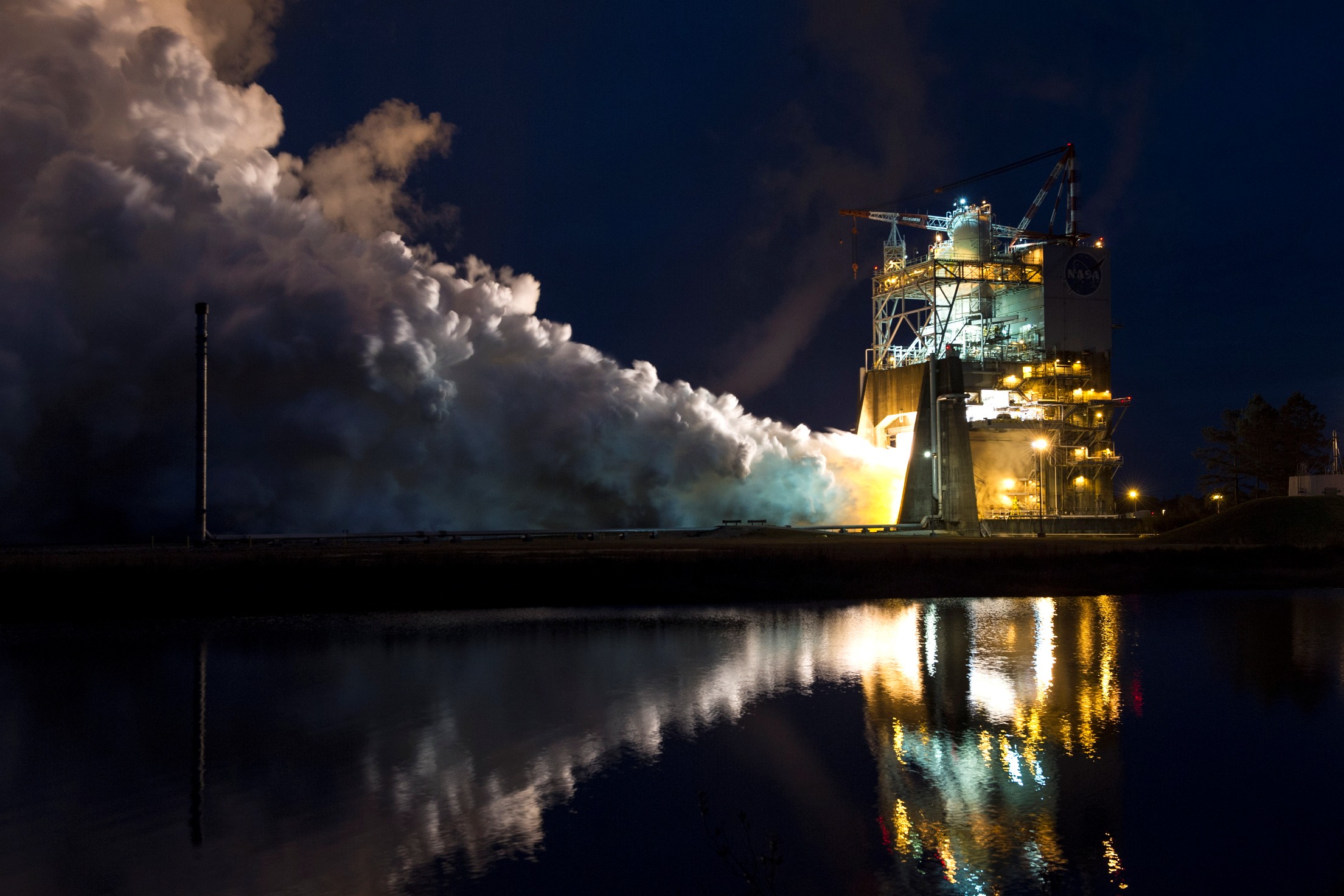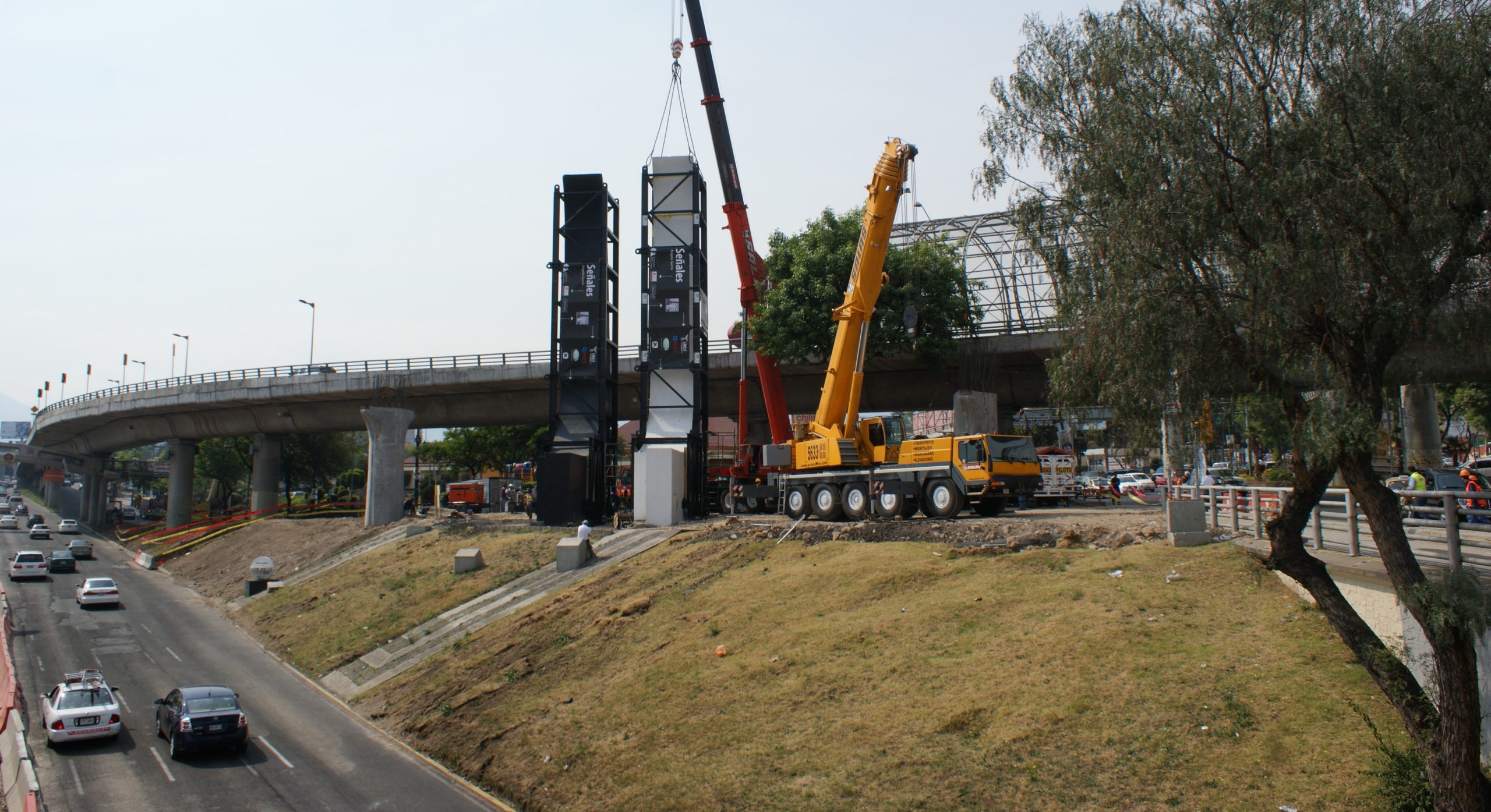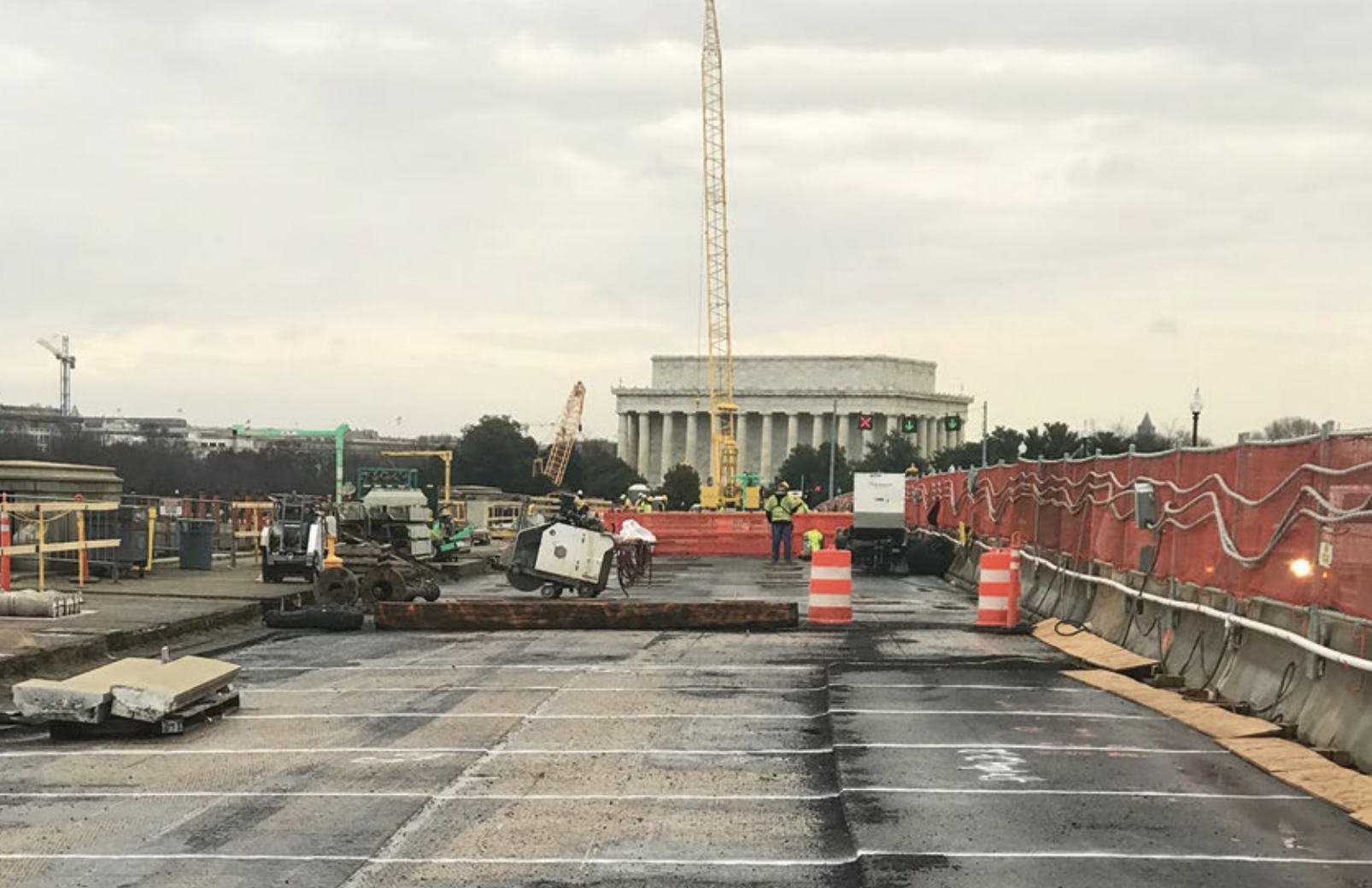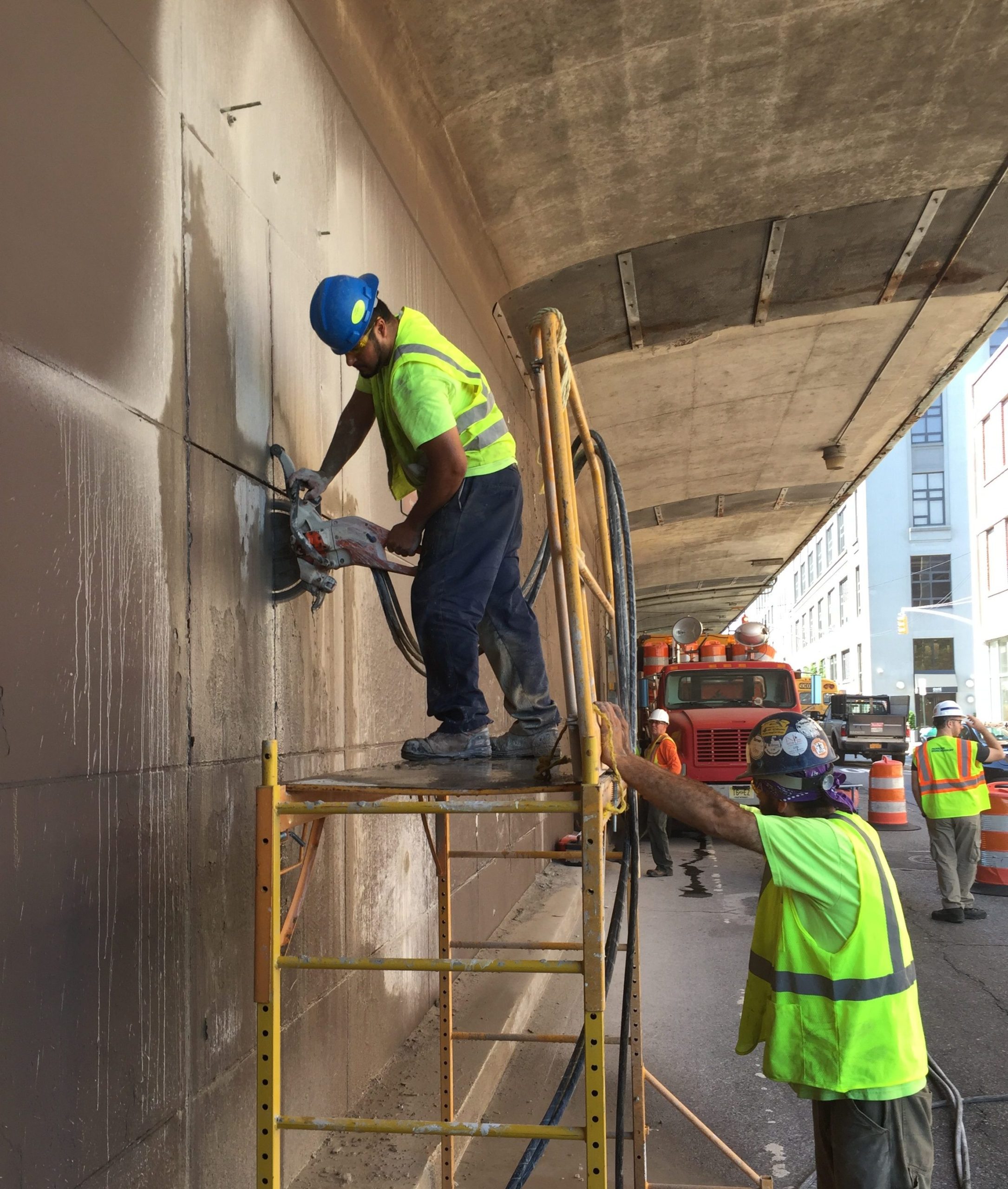
Blast Off!

NASA Test Stand Demolished by Concrete Cutting
(All test stand photos courtesy of NASA)

Horizontal and vertical wire saw cuts provided a clean finish on the foundations walls.
The scheduled demolition of concrete structures, some 400-feet-tall, at a NASA static engine test stand began with the use of explosives. However, more safe and accurate methods were required to bring the structures to set elevations and maintain some of the foundations for reuse. By the end of the project, one cutting contractor had completed over 400 feet of hand and wall sawing, core drilled in excess of 70 holes and used a wire saw to cut over 2,100 square feet of reinforced concrete.
Redstone Arsenal is a United States Army post located in the Tennessee Valley Region of Alabama, near the city of Huntsville. The Arsenal is a garrison for a number of tenants including the United States Army Material Command, the Army’s Aviation and Missile Command, the Missile Defense Agency of the Department of Defense and NASA’s Marshall Space Flight Center. Redstone Arsenal spans over 38,000 acres and includes a 7,200-foot-long airfield runway. It houses a government and contractor workforce that averages 36,000 to 40,000 personnel daily.
The static engine test stand, located in the Marshall Space Flight Center West Test Area, contained two concrete towers standing 400 and 300 feet tall. The stand was deemed outdated and required reconfiguring to test new engines for future space programs. The foundations consisted of approximately 150 linear feet of cutting on each side, and in each corner were 14-foot by 14-foot caissons. On the east end of the stand was a basement area that housed mechanical, electrical and fuel sources. This part of the structure was separated by a concrete wall that was 5 feet thick in some areas.
Following the use of explosives by demolition contractor Britt Demolition of Birmingham, Alabama, the general contractor for the project, Brasfield & Gorrie of Birmingham, required that all remaining structures and foundations be brought to a finish point. These remaining foundations were going to be used as part of the construction of a new stand, so they needed to be free of structural damage and the finish points had to be clean and precise as per the job specifications.
Britt Demolition contracted CSDA member International Drilling & Sawing, Inc. (IDS) of Montgomery, Alabama, to perform precise diamond wire saw cuts that would provide the necessary levels of accuracy for the work. The specialty cutting contractor was to bring all the foundations of the two demolished towers to elevations ranging from 4 feet to 18 feet above grade within a 32-day window.
“Concrete cutting was specified because precise finishes were needed at the proper elevation and the work had to be done without the destruction or damage of the remaining foundations,” said Roy Nelson, production manager for IDS. “Other methods like explosives and track-mounted breakers were used to bring down the towers to within 10 feet of the foundations, but from that point forward a more refined method was needed.”

A series of reinforced concrete structure foundations required cutting to elevation.
A survey crew from Brasfield & Gorrie determined elevation points and established cut lines. From this point, the team from IDS began their work. The first task was for core drilling operators to create a series of 1.5- and 2.5-inch-diameter holes in the foundation walls that ranged from 24 to 60 inches thick using a Shibuya TS-402 core drill supplied by DITEQ. These holes would be used for diamond wire runs so the wire saw could perform cross-sectional pull cuts through the concrete. On average, these holes took around 30 minutes to drill for the thinner walls and up to 90 minutes for the thicker ones. The contractor cored 74 holes in total.
With all core holes complete, IDS used a Diamond Products WS-25 wire saw and two Hydrostress SB wire saws for the cuts. Pulleys were positioned and the wire was threaded through, ready to begin cutting. Horizontal pull cuts measuring between 10 and 14 feet long were made through the foundations walls, taking an average of five hours to complete. Operators also made a series of vertical cuts that ranged from 3 to 12 feet tall to account for elevation changes within some of the remaining structures, such as cutting around door openings. The wire sawing portion of the work accounted for 2,102 square feet of concrete cutting. During these cuts, IDS encountered two, sometimes four mats of 2-inch-diameter rebar on 8-inch centers. In other areas, the reinforcement consisted of #14 rebar on 8-inch centers.
Wall sawing techniques were used to cut top and end sections from three separate concrete trench boxes that housed mechanical, electrical and fuel supplies. This task took two-and-a-half days to complete. The walls and floors were 12 inches thick with two mats of #8 rebar on 12-inch centers.

Some areas of concrete were scored out to expose steel rebar for tie-ins to the new construction.
It was specified that some sections of the foundations structures be scored at 3 feet below the cut lines. This was so that the concrete between the scored lines and the cut line could be chipped out by the demolition contractor, exposing the steel reinforcement. This steel was used by the general contractor to tie back into during construction of the new test stand. IDS performed 174 feet of hand sawing at the jobsite from depths of 2 inches to 10 inches using a Core Cut 16-inch hand saw from Diamond Products. Where necessary, operators worked from an all-terrain scissor lift and were tied off at all times.
The cutting work was scheduled during the months of July and August 2014, which are often hot and stormy months in Alabama, with average high temperatures of 91 degrees Fahrenheit. IDS, being a local contractor and used to this type of environment, took the necessary steps to protect workers while working in the summer heat—especially those working below grade where there was less wind to cool operators. The team was able to work through the unsettled weather, but incurred some downtime when conditions deteriorated. NASA representatives monitored the area for lightning and severe weather activity, and notified all contractors when necessary. Although unavoidable, this downtime meant less time to complete the work.
Britt Demolition had been given 35 days to complete this phase of the project, which was quite a tight time frame given the size of the task. The demolition contractor continued its work while IDS was on site, which created some uneven ground surfaces for the cutting contractor to work from. After the first week of cutting, IDS was asked to provide more crews and work seven days a week to keep within these time constraints. Once the cutting contractor increased its presence at the test stand, the work was completed on time and without incident. Daily Job Safety Analysis forms were completed and discussed before cutting commenced, and was just one of the reasons why the work was completed safely.
“Our knowledge of wire sawing techniques and our ability to work within these types of government installations helped us win this project. We had a good relationship with the general contractor, understood the scope of work and were able to quickly adapt when needed,” said Nelson. “I would like to give mention to Jeff Doss, Wes Henry, Matt Jeffers, Jason Weaver, Michael White and Travis Wilson for going above and beyond to get this job done,” he concluded.
The new static engine test stand at NASA’s Marshall Space Flight Center within Redstone Arsenal is near completion, and will soon allow the Agency to assess state-of-the-art rockets and engines for future space programs.
NASA’s Marshall Space Flight Center is situated on the U.S. Army’s Redstone Arsenal in Huntsville, Alabama. The center’s history reaches back to 1957, the year before NASA was created, and was established partially in response to the Soviet Union’s launch of the first artificial satellite, Sputnik, in 1956. A group of Army employees working then on rocket and missile programs at Redstone Arsenal included a team of German scientists led by Dr. Wernher von Braun. Dr. Braun was largely responsible for the successful launch of the United States’ first satellite, Explorer 1, in 1958. In 1960, NASA established the Marshall Center with the transfer from the Army of more than 4,500 civil service employees and nearly 2,000 acres of Redstone Arsenal property.
Marshall minds designed, built, tested and helped launch the giant Saturn V rocket that carried astronauts on the Apollo missions to the moon. Marshall developed new rocket engines and tanks for the fleet of space shuttles, built sections of the International Space Station (ISS) and now manages all the scientific work of the astronauts aboard the ISS from a 24/7 Payload Operations and Integration Center. It is also currently the development home of the Space Launch System (SLS), the most powerful rocket ever designed to carry human explorers, their equipment and science payloads deeper into space than ever before—to an asteroid and to Mars. Marshall manages the Michoud Assembly Facility, where the core stage of SLS is under construction with a unique set of leading-edge tools, including the largest spacecraft welding tool in the world, the 170-foot-tall, 78-foot-wide Vertical Assembly Center. For more information, visit www.nasa.gov/centers/marshall.
Company Profile
A CSDA member since 1996, International Drilling & Sawing, Inc. has been in business for 21 years. The company is based in Montgomery, Alabama and has support locations in Birmingham and Pensacola, Florida. IDS employs 28 operators, has 18 trucks and offers the concrete cutting services of slab sawing, wall sawing, hand sawing, wire sawing, core drilling, selective demolition and GPR imaging. IDS is a CSDA Certified Operator company.
Resources
General Contractors:
Brasfield & Gorrie, Britt Demolition
Sawing and Drilling Contractor:
International Drilling & Sawing, Inc.
Montgomery, Alabama
Phone: 334-288-2355
Email: terry@idscuts.com
Website: www.idscuts.com
Methods Used: Wire Sawing, Hand Sawing, Core Drilling














